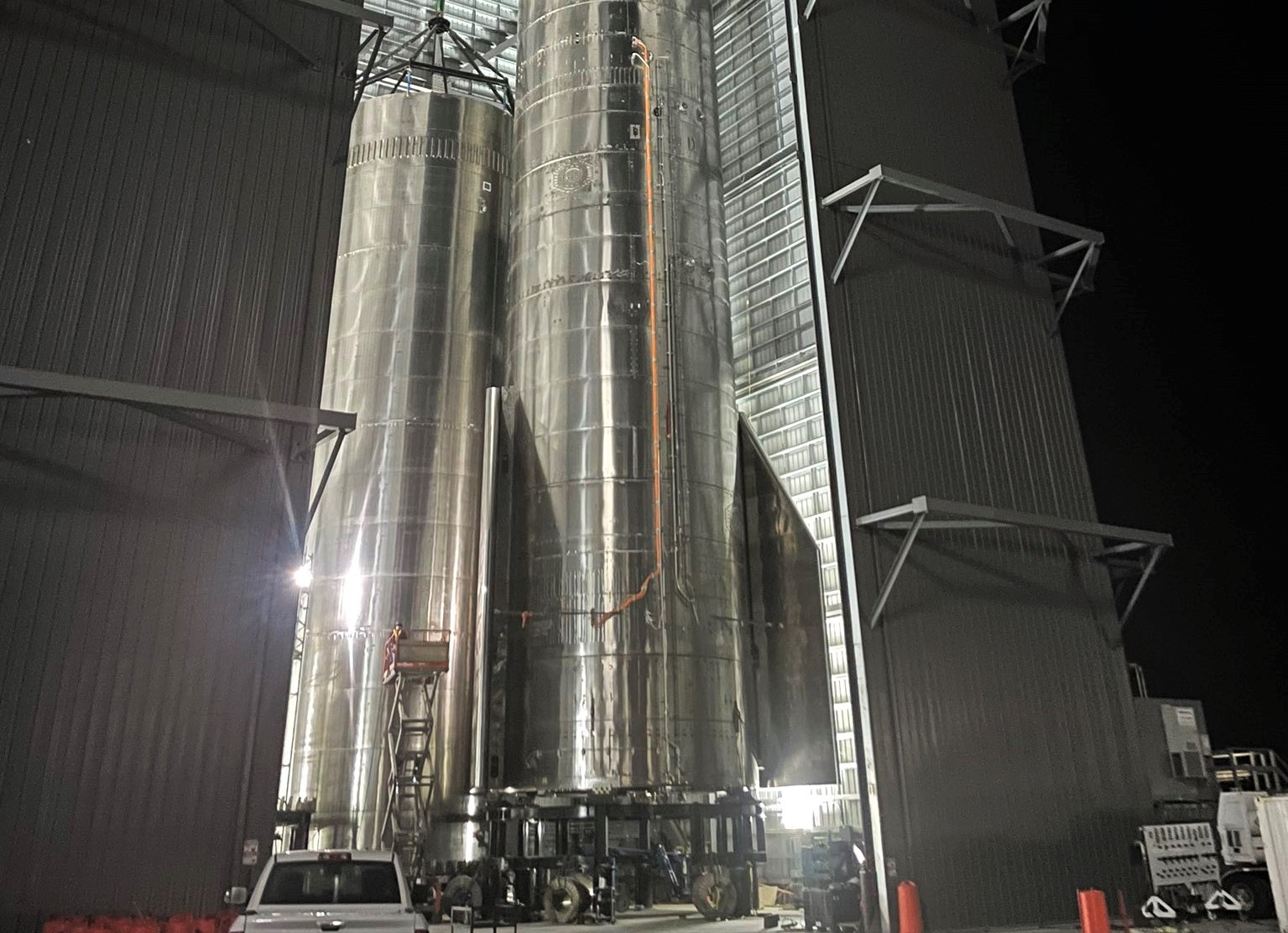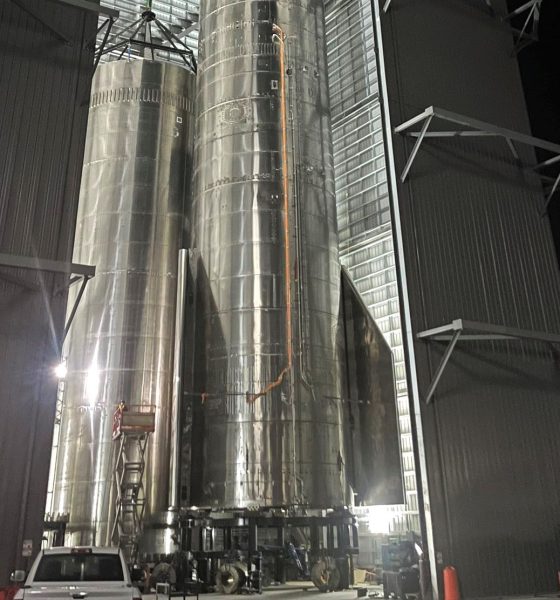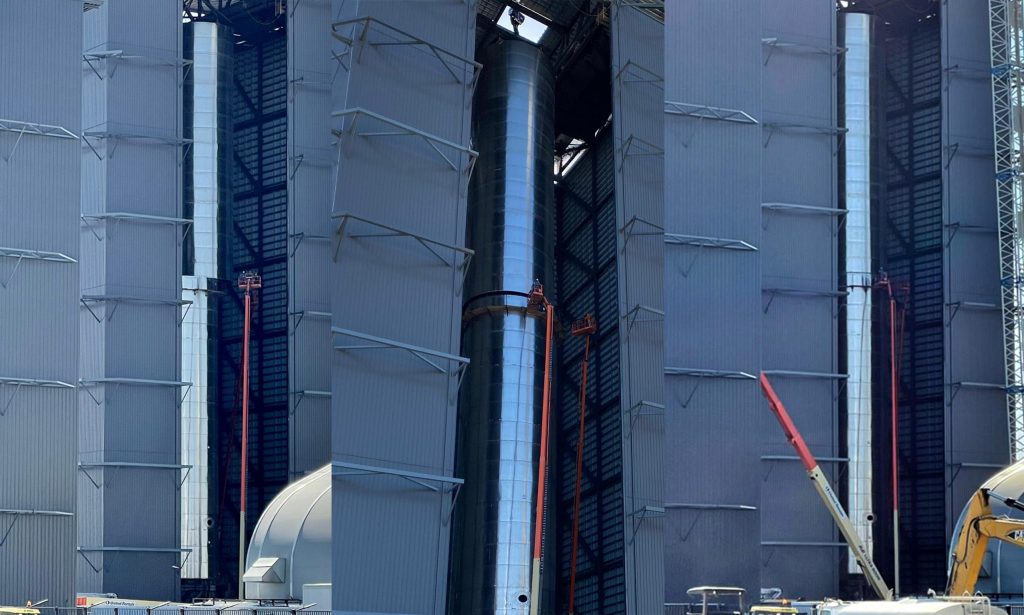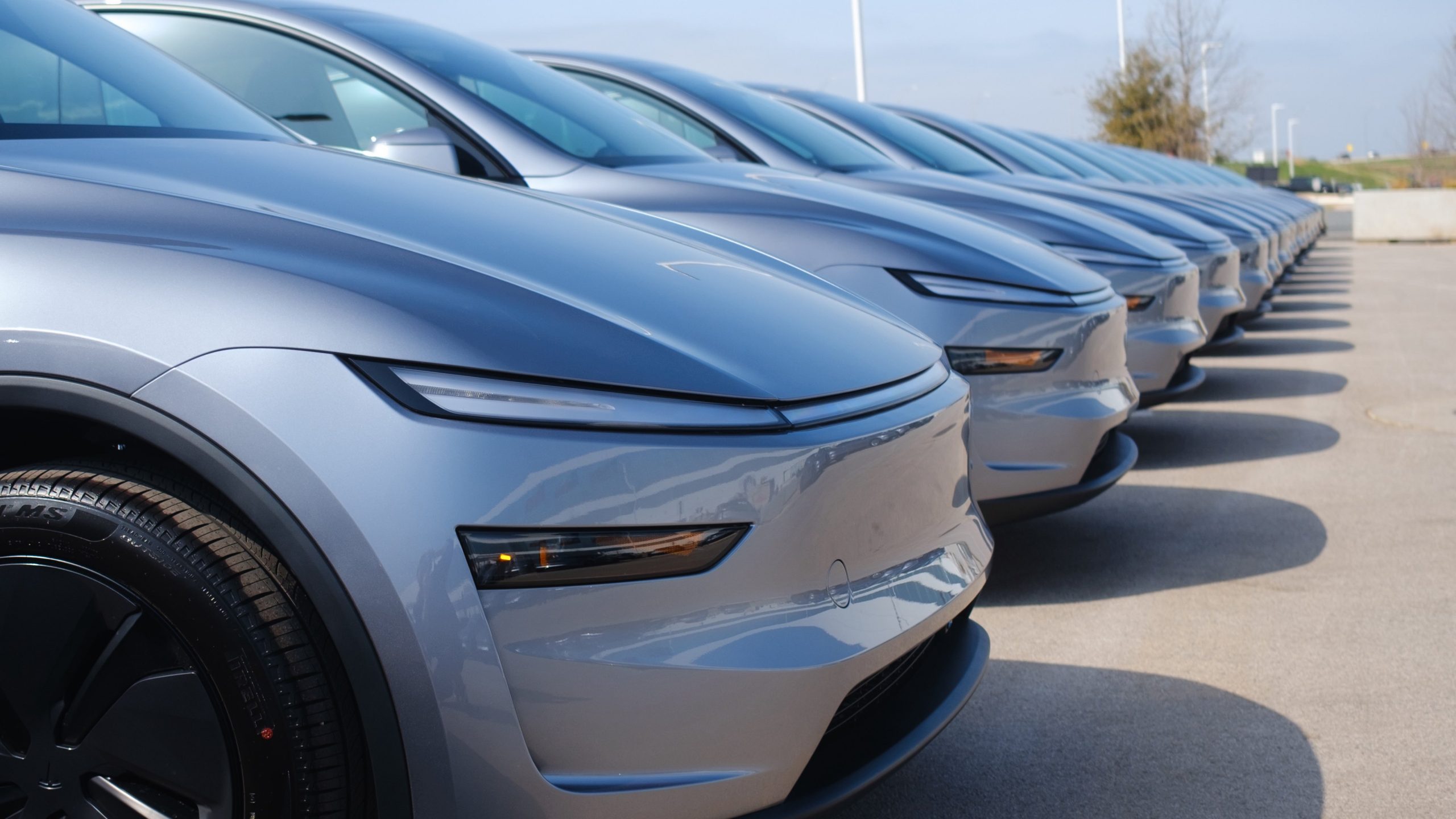

News
Elon Musk says SpaceX’s second Starship booster prototype is almost finished
SpaceX CEO Elon Musk says that the second Starship booster prototype is “almost done” and has revealed that work on the first flightworthy booster has yet to begin.
For unknown reasons, SpaceX has recently changed the naming scheme for Starship and Super Heavy boosters. The booster SpaceX is currently assembling in Boca Chica has been referred to as “Booster 2” by Musk himself but, according to NASASpaceflight, is internally known as Booster 3 or B3, replacing its former Booster Number 3 (BN3) designation.
Regardless, SpaceX began stacking the Super Heavy booster prototype now known as B3 in mid-May. Around six weeks later, 23 or 24 rings have been stacked to create a partially finished prototype 9m (~30 ft) wide and approximately 42m (~140 ft) tall.
Just like Super Heavy ‘pathfinder’ BN1, which was scrapped almost the instant it reached its full height last March, Booster 3 appears to destined to stand 36 rings – 65m (~215 ft) – tall once complete. While drastically oversimplifying the process of vertically assembling the largest rocket booster ever built, that means that Super Heavy B3 is just shy of two-thirds (~65%) complete.
By simply averaging the time it’s taken for SpaceX to stack B3 to a height of 42 meters, the booster could reach its full height around three weeks from now (July 15th, give or take a week). For the most part, the most challenging and unfamiliar parts of Super Heavy B3 manufacturing and assembly have already been completed. Relative to Starship, which SpaceX has now built more than half a dozen prototypes of, Super Heavy is just a stretched Starship with no flaps, no nosecone, a far more complex engine section, and a forward dome section that needs to support car-sized grid fins.
Super Heavy’s larger propellant tanks also require a methane transfer tube – used to carry methane through the booster’s lower liquid oxygen tank – more than twice as tall as anything built for Starship. By all appearances, that ~35m (~115 ft) tall transfer tube has already been safely installed inside B3’s incomplete tanks. Around June 14th, B3’s lower two-thirds were effectively completed when its LOx tank stack was mated to the booster’s 29-Raptor engine section.

Outfitted with complex structural modifications to support massive grid fins and the first advanced ‘hot gas’ maneuvering thrusters ever spotted in public, Booster 3’s forward dome is already in the process of being welded to a stack of three steel rings. Once complete, the rest of Super Heavy B3 integration is fairly simple as far as rocket assembly goes and will require four more welding operations. Like BN1, there’s a good chance that SpaceX will mate Booster 3’s upper (methane) tank separately and then install the ~24m (~80 ft) tall, 13-ring section on top of the LOx stack to effectively complete the booster’s main structure
Of course, after the structure is complete, SpaceX will still need to finish plumbing, wiring, and generally outfitting a Super Heavy booster for the first time ever. Finally, while it remains to be seen just how finished B3 will actually find itself before heading to the launch pad, that process could also involve installing and testing four massive steel grid fins and, most importantly, up to 29 Raptor engines – a figure only beaten by the Soviet Union’s ill-fated N1 rocket.
Perhaps most significantly, Musk also revealed that B3 is not the Super Heavy booster assigned to Starship’s first orbital launch attempt, meaning that SpaceX will have to complete Booster 3 testing and build Booster 4 before that orbital test flight can occur. Given that Booster 3 assembly is on track to take more than nine weeks, Starship’s first orbital launch attempt is thus unlikely to happen before late August or September.

News
Tesla expands Model 3 lineup in Europe with most affordable variant yet
The Model 3 Standard still delivers more than 300 miles of range, potentially making it an attractive option for budget-conscious buyers.

Tesla has introduced a lower-priced Model 3 variant in Europe, expanding the lineup just two months after the vehicle’s U.S. debut. The Model 3 Standard still delivers more than 300 miles (480 km) of range, potentially making it an attractive option for budget-conscious buyers.
Tesla’s pricing strategy
The Model 3 Standard arrives as Tesla contends with declining registrations in several countries across Europe, where sales have not fully offset shifting consumer preferences. Many buyers have turned to options such as Volkswagen’s ID.3 and BYD’s Atto 3, both of which have benefited from aggressive pricing.
By removing select premium finishes and features, Tesla positioned the new Model 3 Standard as an “ultra-low cost of ownership” option of its all-electric sedan. Pricing comes in at €37,970 in Germany, NOK 330,056 in Norway, and SEK 449,990 in Sweden, depending on market. This places the Model 3 Standard well below the “premium” Model 3 trim, which starts at €45,970 in Germany.
Deliveries for the Standard model are expected to begin in the first quarter of 2026, giving Tesla an entry-level foothold in a segment that’s increasingly defined by sub-€40,000 offerings.
Tesla’s affordable vehicle push
The low-cost Model 3 follows October’s launch of a similarly positioned Model Y variant, signaling a broader shift in Tesla’s product strategy. While CEO Elon Musk has moved the company toward AI-driven initiatives such as robotaxis and humanoid robots, lower-priced vehicles remain necessary to support the company’s revenue in the near term.
Reports have indicated that Tesla previously abandoned plans for an all-new $25,000 EV, with the company opting to create cheaper versions of existing platforms instead. Analysts have flagged possible cannibalization of higher-margin models, but the move aims to counter an influx of aggressively priced entrants from China and Europe, many of which sell below $30,000. With the new Model 3 Standard, Tesla is reinforcing its volume strategy in Europe’s increasingly competitive EV landscape.
News
Tesla FSD (Supervised) stuns Germany’s biggest car magazine
FSD Supervised recognized construction zones, braked early for pedestrians, and yielded politely on narrow streets.

Tesla’s upcoming FSD Supervised system, set for a European debut pending regulatory approval, is showing notably refined behavior in real-world testing, including construction zones, pedestrian detection, and lane changes, as per a recent demonstration ride in Berlin.
While the system still required driver oversight, its smooth braking, steering, and decision-making illustrated how far Tesla’s driver-assistance technology has advanced ahead of a potential 2026 rollout.
FSD’s maturity in dense city driving
During the Berlin test ride with Auto Bild, Germany’s largest automotive publication, a Tesla Model 3 running FSD handled complex traffic with minimal intervention, autonomously managing braking, acceleration, steering, and overtaking up to 140 km/h. It recognized construction zones, braked early for pedestrians, and yielded politely on narrow streets.
Only one manual override was required when the system misread a converted one-way route, an example, Tesla stated, of the continuous learning baked into its vision-based architecture.
Robin Hornig of Auto Bild summed up his experience with FSD Supervised with a glowing review of the system. As per the reporter, FSD Supervised already exceeds humans with its all-around vision. “Tesla FSD Supervised sees more than I do. It doesn’t get distracted and never gets tired. I like to think I’m a good driver, but I can’t match this system’s all-around vision. It’s at its best when both work together: my experience and the Tesla’s constant attention,” the journalist wrote.
Tesla FSD in Europe
FSD Supervised is still a driver-assistance system rather than autonomous driving. Still, Auto Bild noted that Tesla’s 360-degree camera suite, constant monitoring, and high computing power mark a sizable leap from earlier iterations. Already active in the U.S., China, and several other regions, the system is currently navigating Europe’s approval pipeline. Tesla has applied for an exemption in the Netherlands, aiming to launch the feature through a free software update as early as February 2026.
What Tesla demonstrated in Berlin mirrors capabilities already common in China and the U.S., where rival automakers have rolled out hands-free or city-navigation systems. Europe, however, remains behind due to a stricter certification environment, though Tesla is currently hard at work pushing for FSD Supervised’s approval in several countries in the region.
News
Tesla reliability rankings skyrocket significantly in latest assessment
“They definitely have their struggles, but by continuing to refine and not make huge changes in their models, they’re able to make more reliable vehicles, and they’ve moved up our rankings.”

Tesla ranked in the Top 10 of the most reliable car companies for 2026, as Consumer Reports’ latest index showed significant jumps from the past two years.
In 2022, Tesla ranked 27th out of 28 brands. Last year, it came in 17th.
🚨🚨 Tesla entered the Top 10 in Consumer Reports’ list of reliable carmakers for the first time
In the past two years, Tesla has ranked 17th in 2024 and 27th out of 28 brands in 2022.
Subaru, BMW, Porsche, Honda, and Toyota were the Top 5 OEMs in the rankings. pic.twitter.com/z216bccVoH
— TESLARATI (@Teslarati) December 4, 2025
However, 2026’s rankings were different. CR‘s rankings officially included Tesla in the Top 10, its best performance to date.
Finishing tenth, the full Top 10 is:
- Subaru
- BMW
- Porsche
- Honda
- Toyota
- Lexus
- Lincoln
- Hyundai
- Acura
- Tesla
Tesla has had steady improvements in its build quality, and its recent refinements of the Model 3 and Model Y have not gone unnoticed.
The publication’s Senior Director of Auto Testing, Jake Fisher, said about Tesla that the company’s ability to work through the rough patches has resulted in better performance (via CNBC):
“They definitely have their struggles, but by continuing to refine and not make huge changes in their models, they’re able to make more reliable vehicles, and they’ve moved up our rankings.”
He continued to say that Tesla’s vehicles have become more reliable over time, and its decision to avoid making any significant changes to its bread-and-butter vehicles has benefited its performance in these rankings.
Legacy automakers tend to go overboard with changes, sometimes keeping a model name but recognizing a change in its “generation.” This leads to constant growing pains, as the changes in design require intense adjustments on the production side of things.
Instead, Tesla’s changes mostly come from a software standpoint, which are delivered through Over-the-Air updates, which improve the vehicle’s functionality or add new features.
Only one Tesla vehicle scored below average in Consumer Reports’ rankings for 2026 was the Cybertruck. Fisher’s belief that Tesla improves its other models over time might prove to be true with Cybertruck in a few years.
He continued:
“They’re definitely improving by keeping with things and refining, but if you look at their 5- to 10-year-old models that are out there, when it comes to reliability, they’re dead last of all the brands. They’re able to improve the reliability if they don’t make major changes.”
Regarding Subaru’s gold medal placing on the podium, Fisher said:
“While Subaru models provide good performance and comfort, they also excel in areas that may not be immediately apparent during a test drive.”
Other notable brands to improve are Rivian, which bumped itself slightly from 31 to 26. Chevrolet finished 24th, GMC ended up 29th, and Ford saw itself in 18th.








